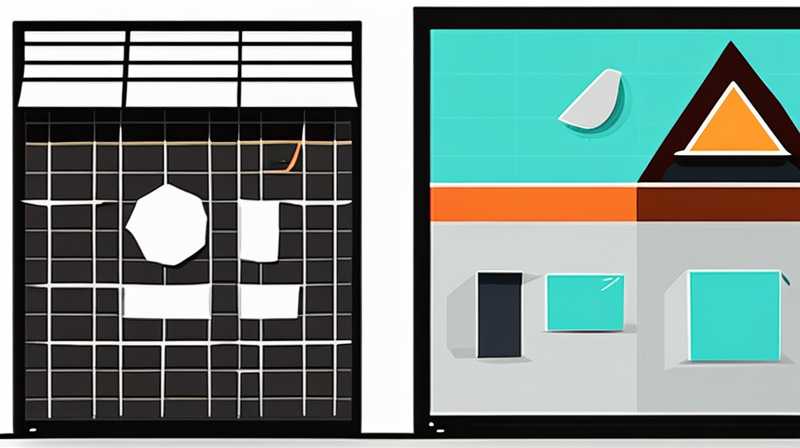
1. RECOGNIZING THE LEAK SOURCE
Identifying the precise location of a leak is crucial for a successful repair. Familiarize yourself with the common causes, such as damaged panels, failed seals, or improper installation. These areas typically show signs of wear or damage, including visible gaps, cracks, or discoloration. An in-depth inspection can unveil hidden leaks, often found where the solar panels interface with the roofing material. Utilizing tools like thermal imaging cameras can facilitate this process, revealing temperature fluctuations that correspond with moisture intrusion.
2. GATHERING THE NECESSARY TOOLS AND MATERIALS
Before undertaking any repair, it is essential to assemble the correct tools and materials. Common tools include a soft brush for cleaning, a high-quality sealant or caulk specifically designed for roofing applications, and a putty knife for applying these materials. Depending on the severity of the leak, you may also need roofing fabric or specialized adhesives for more extensive repairs. Ensure you also have safety equipment, such as gloves and goggles, to protect yourself throughout the process.
3. CLEANING AND PREPARING THE LEAK AREA
Once the source of the leak is identified, meticulous cleaning of the affected region is paramount. Begin by detaching any debris, dust, or algae that may obstruct the repair. A clean surface guarantees maximum adhesion of sealants or adhesives. If necessary, wash the area with mild soap and water, followed by a thorough rinsing. Scraping off any old, peeling sealant is also advisable to create a better bond with new materials. Inspect again after cleaning to confirm that all signs of damage are visible.
4. APPLYING SEALANTS OR ADHESIVES
The next step involves the application of sealants or adhesives designed to withstand harsh weather conditions and provide long-lasting protection. Using a putty knife, apply an appropriate amount of sealant into any cracks or gaps identified during inspection. Make sure to force the sealant deep into the gap to ensure a thorough fill. For larger holes, consider layering the adhesive with roofing fabric for enhanced durability. After applying, it’s essential to smooth the sealant evenly to form a secure bond.
5. CHECKING AND MONITORING
Once the repairs have been executed, ongoing vigilance is necessary. Monitor the repaired areas during subsequent rain events to ascertain the effectiveness of your repair strategy. Document any changes or new leaks as they arise and keep a schedule for regular inspections to prevent future problems. It is also wise to consider installing leak detection systems that can alert you immediately if new leaks develop. By implementing a solid maintenance routine, you can extend the lifespan of your solar roof.
FAQs
WHAT CAUSES A SOLAR ROOF TO LEAK?
Several factors can contribute to leaks in a solar roof system, including environmental conditions, poor installation, and material degradation. High winds can displace panels, rendering seals ineffective. The sun’s UV rays also cause roofing materials to deteriorate over time. Additionally, improper sealing during installation may create voids where moisture can infiltrate. Regular inspections and proactive maintenance can mitigate these issues, ensuring that the system operates efficiently and remains intact. Addressing installation errors immediately is critical to preventing further decay and maintaining the integrity of the roof.
HOW CAN I PREVENT LEAKS IN THE FUTURE?
Preventing leaks involves a proactive approach to maintenance and monitoring. Regular inspections should be scheduled to assess the condition of the solar panels, seals, and surrounding roofing materials. Cleaning debris from the roof prevents water accumulation, reducing the risk of leaks developing over time. Additionally, choosing high-quality materials for both the roofing and solar panels can significantly enhance durability. Installing monitoring systems that detect moisture can be an effective measure as it allows for immediate action before extensive damage occurs.
WHEN SHOULD I CALL A PROFESSIONAL?
While minor repairs can be managed independently, certain situations necessitate expert intervention. Consulting a professional is wise if the leak is extensive, involves electrical components, or if the roof is difficult to access. Professionals possess the skills and tools to diagnose leaks accurately, ensuring the repair is effective and safe. Additionally, if there are signs of extensive damage to your roof’s structure or the solar panels, expert assessment is critical to avoid potential hazards. Safeguarding your investment in solar technology is essential for long-term benefits.
6. CONCLUDING THOUGHTS
Repairing a leaky solar roof is a multifaceted endeavor that encompasses several crucial steps. From detecting the leak’s origin to applying appropriate sealants, each stage demands precision and attention to detail. Understanding the potential causes of leaks—such as environmental wear, poor installation, or material failure—forms the foundation of effective remedial action. Once the leak’s source has been identified, preparation for the repair can commence, involving assembling the necessary tools and materials. Cleaning the repair area is vital for ensuring that new sealants adhere adequately and provide lasting protection against moisture ingress.
Following this, the application of high-quality sealants or adhesives must be executed meticulously, ensuring complete coverage of any damaged sections. Thereafter, it’s important to monitor the repair’s effectiveness during subsequent weather events and implement a routine inspection program, thereby minimizing the chance of future leaks developing. If at any point the repair process seems overwhelming or complex, knowing when to seek professional assistance is crucial for your safety and the longevity of your solar roofing system. This proactive mindset towards maintenance will not only extend the roof’s life but also enhance the performance of the solar energy system it supports.
Ultimately, a well-maintained solar roof can continue to deliver reliable energy for years, avoiding the costly repercussions of neglect. Therefore, staying engaged with regular upkeep and being vigilant about potential problems forms a critical aspect of responsible solar roof management.
Original article by NenPower, If reposted, please credit the source: https://nenpower.com/blog/how-to-repair-a-leaky-solar-roof/


